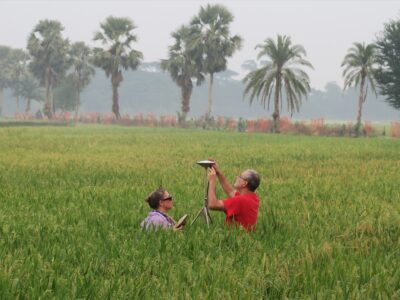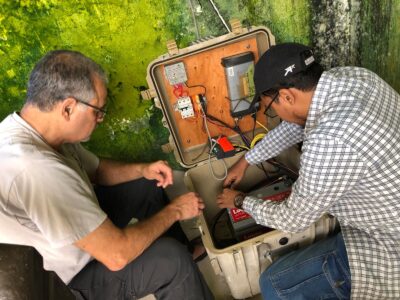
Our last new site on the Bawali was farther north and west. We sailed north along the edge of the Sundarbans and turned west stopping for the night near a bridge. A lot of the land along the river we were seeking had been turned to farmland, so the Bawali could not continue much farther. As sediment is deposited along the river bank, people claim it, build low embankments and start farming rice or shrimp.

This is called khas land. It officially belongs to the government, but is squatted upon by the local people. In some cases, rivers are completely closed off. Carol estimated the amount of khas land being created and found it is equal to Chris’ estimate of the land lost to sea level rise along the Sundarbans. When you add in the new land still being created by sedimentation at the mouth of the Ganges-Brahmaputra-Meghna River, Bangladesh is still growing.

One of the Bawali’s crew went ashore and hired a local country boat for the rest of our journey. We boarded the next morning and continued on. We passed the school I had picked but could see that it was surrounded by tall trees and not suitable for a GPS station. As we continued on, the river narrowed due to the khas land. Twice fisherman had to move their nets so we could pass. Finally we could see that we could not make it upstream to the next school.

A few of us got off and sloshed through the mud to scout for a school. Salam talked to people we met. They confirmed that there were several schools a few kilometers up the embankment road, but they weren’t sure if they were concrete cyclone shelters. However, the new school two kilometers inland was definitely a cyclone shelter. We hired two local pickup trucks — a flat wooden bed attached to a bicycle. These are electrically powered so each could carry three of us.

We bumped along on the bumpy, worn brick road until we could see the tall school jutting out above the trees. It was perfect and had rice, rather than shrimp fields, in front of it.
We sent for the headmaster and got permission to use the school. We sent word for the rest of the people and equipment to come and sent a flotilla of rickshaw vans to get them. We decided the small upper roof over the staircase was perfect. It was difficult to get to without a ladder and had an overhang that would shade the box from the sun. Meanwhile, Carol negotiated for a site in the rice field and went to went back to the river to find a second site outside the embankment while her now experienced team installed the first SET.

The GPS took longer than we expected, partly because we drained the battery of the hammer drill. Since Carol needed the spare for an angle grinder, we had a break while it was recharged by our large batteries for the GPS. It wasn’t enough and we had to send for the spare battery by motorcycle taxi. We had some tea, visited the local Hindu temple and chatted. The people were very interested in what we were doing, as at other site. They very much want to know if their land is sinking and at what rate. They are sure that our results would never filter down to them. Since a team must visit the SET every six months, we agreed to send word of our results as they develop. It was late in the afternoon when we finished and took the bumpy ride back. At the embankment, we found some of the others ordering snacks from a stand.

They fried piazu, onion and lentil fritters and potato-stuffed singara (pakoras) as the sun set and it became dark. We ate them on the country boat as it sailed back to the Bawali.
The next morning, we stopped at my existing Polder 32 to do some upgrades. I have been to this site on an embanked island several times. It was flooded for almost two years when Cyclone Aila breached its embankment in multiple places. Sinking of the land inside the polders where it is not replenished by fresh sediment left the land inside 1 to 1.5 meters below the natural level so it was flooded every high tide. This is why we need to understand the dynamics of this part of the delta. After a few hours we were back on our way and headed to Khulna, the home port of the Bawali a day early.

We had two tasks in Khulna. One was to visit our sediment compaction site and provide some upgraded equipment to the family that does the measurements. We have six wells from 20-300 m that have optical fiber strain meters in them. Since 2011, once a week, one of the four brothers used to use a laser device to measure the length of the fiber so we could track how the sediments compact leading to subsidence. Measurements had been interrupted by computer problems and I was bringing a new computer and upgraded laser device. When I was there in 2015, we watched as the small channel next to the wells was dredged to make it navigable again. The engineer tried to avoid them, after dredging the channel adjusted its shape. The tall GPS tower tilted over in 2017. Now Hafizur sent me photos showing the wells had collapsed into the river as well. We visited anyway.

Only one of the six wells was left. We pried off the lid and tried to make a measurement, but got zero length. The top was no longer connected to the fibers. At least we have enough data for some good results. We had a snack including fantastic fresh mango, chatted with the family I’ve known since 2011 and were on our way.


While most of us went to the compaction meter, John and Sanju returned to the first site by car to fix a few minor things. Amazingly, it took them only two and a quarter hours to get there from Khulna. The landowner, Bachchu, was thrilled to see them and gave them big bear hugs. They also returned his screw driver.
At the school, one of the children, Imran, showed how other students were playing with the ground wire and they fixed that as well. As it was Saturday and we could not go to Khulna University, we went to nearby Bagherat, home to the famous 60-dome mosque built in the 15th century. We saw the tomb of Khan Jahan, who founded the area and built the mosque, then continued on to the famous mosque itself.

John and Sanju, on their way back joined us there. When we were done, I wanted to visit two other historic mosques nearby that had been used as markers of subsidence. After a wrong turn, we found the correct road, but it was in really bad shape and we could barely drive it. We got to the first mosque as darkness and rain both started to fall and prayers were going on inside. After a little time there we abandoned going to the second one and headed back to Khulna.






